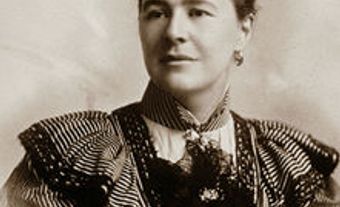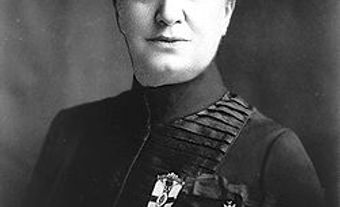Women's Organizations
In the early 19th century affluent women grouped together at the local level for charitable and religious purposes. They set up shelters and orphanages to help needy women and children, and worked for their churches through ladies' auxiliaries. By the end of the 19th century these activities had expanded to include myriad interdenominational and secular reform organizations, such as the Woman's Christian Temperance Union, the Young Women's Christian Association and the National Council Of Women.
Unlike earlier groups, these organizations were national in scope and appealed to a much broader segment of Canadian womanhood. They sought to improve society and were willing, in specific instances, to use the power of the state through compulsory legislation to effect reforms. These societies were often motivated by an evangelical persuasion, and continued to concentrate their efforts on helping needy women and children.
Women who joined these organizations felt a responsibility to become involved in society. For the most part they accepted women's domestic role, but due to the increasing influence of society within the family the organizations were convinced that their position required a more public image. This seemed particularly true in urban areas, where alcoholism, prostitution, delinquency and disease were prevalent. Rural women anticipated the challenge of urbanization and wanted to overcome the problems of isolation and depopulation. Farmers' organizations in the early 20th century accepted women's auxiliaries and associations as an integral part of the farmers' movement. Women's institutes became so successful that they were established throughout the world (see Federated Women's Institute Of Canada). In addition to the women's organizations that were organizational or administrative, many others existed that were expressive, designed solely for the benefit of their membership. Some, such as reading and musical associations, catered to the woman at home, but others represented the specific needs of professional women such as teachers and nurses (see Women In The Labour Force).
By 1912 it was estimated that one out of every 8 adult women in Canada belonged to a women's group, making the women's organizational movement a significant force in Canadian society. However, it was not a movement that appealed to all women. Joiners were mainly middle-aged, middle class, English-speaking and Protestant. French-speaking and Roman Catholic women found the Catholic Church with its sisterhoods and groups a rich source of organizational life. Not until the early 20th century did these women organize such societies as the Fédération nationale St-Jean-Baptiste, which agitated for change in society along the same lines as English-speaking and Protestant initiatives (see St-Jean Baptiste Society). Nevertheless, religious inspiration and influence remained more significant for them than for English-speaking Canadians. Minority women (either through race, ethnicity or religion) did not always feel welcome in mainstream women's organizations; therefore they often created their own societies to work for the benefit of their communities and the women in them.
The work of the instrumental organizations was impressive. They made the public aware of the needs of working women, the deficiencies of the educational system, the problems associated with intemperance, the existence of the double standard of morality between men and women, and the abysmally high infant mortality rate in some Canadian cities. Women's participation in these groups helped change the image of Canadian women.
By joining together, women experienced the power of collective action and the joys of sisterhood. They also learned how to be administrators and fundraisers. When they encountered resistance to reform they came face to face with the limits of their power as women. They learned that because they lacked the right to vote, politicians were unsympathetic and would not respond to their requests. This encouraged a concerted effort by many women's organizations to lobby and support Women's Suffrage during the second decade of the 20th century (see Persons Case and McCLung, Nellie Letitia).
After women gained the right to vote at the federal level in 1918, there was no longer one cause that joined the various women's groups and they lost some of their visibility and appeal. Yet by no means were Canadian women's organizations dormant from the 1920s to the 1960s. The biggest change was that myriad activities replaced the previous agenda and its emphasis on one or 2 specific reforms. During the inter-war years, for example, the church and peace movements became a priority for many women (see Women's International League For Peace And Freedom). Female workers and professionals each participated in groups that represented their individual interests, including Business and Professional Women's Clubs and teachers' federations (see Women's Labour Leagues).
Organizational life was a key forum for Canadian women's volunteer efforts during both world wars, when women gave expression to their patriotism through fundraising, food production and overseas shipments of soldier comforts. At the end of World War II a renewed emphasis on domesticity meant that women were again encouraged to participate in community groups that emphasized homemaking, home and school associations, and consumer advocacy. The post-war emphasis was squarely upon traditional female roles, including nurturing the family and fostering community activity.
Young women became less attracted to the established movements, preferring to explore their individual interests. Nonetheless, women's groups at the national and local level continued their efforts. With the emergence of the Women's Movement in the late 1960s a new organizational impetus emerged, first heralded by the Voice Of Women in 1960. Added to the older groups were new self-directed initiatives that concentrated their activities on increasing women's awareness of their subordinate status in society. Once again public attention was focused on the collective action of women, and out of this awareness developed specific groups for Native women, working women, ethnic women and lesbian women. In addition, the National Action Committee On The Status Of Women emerged as a political voice that lobbied on behalf of Canadian women.
Today new challenges face Canadian women's organizations concerned with the Status Of Women. Generally the shared direction is toward a fundamental shift in the way women are treated and perceived by society. However, that singleness of purpose sometimes recedes from view when groups that cater to narrowly defined identities dominate the agenda. At the heart of these vigorous debates is the fact that the category "woman" is not a homogeneous one. Given the different priorities that arise because of social class, ethnic identity or sexual orientation (to cite only a few examples), co-ordinating the many voices of Canadian feminism is no easy task. The biggest challenge currently facing women's organizations in Canada is how to proceed with activism while giving full voice to competing ideologies that highlight difference.

 Share on Facebook
Share on Facebook Share on X
Share on X Share by Email
Share by Email Share on Google Classroom
Share on Google Classroom


